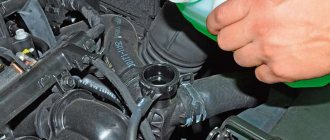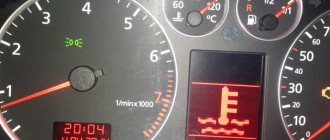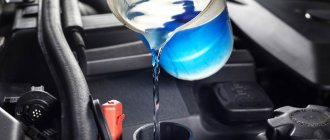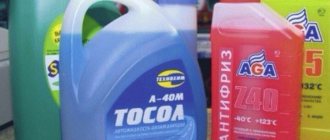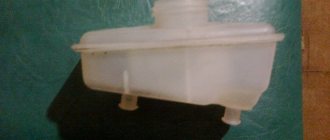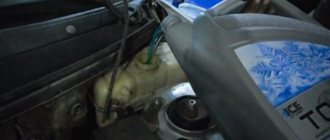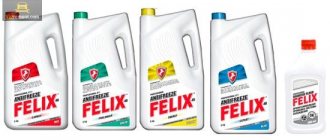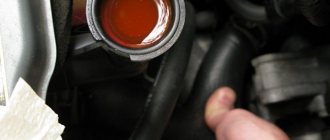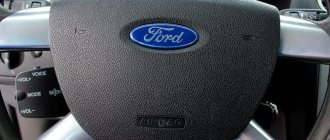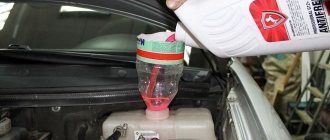How to choose a good coolant?
When choosing antifreeze, first of all you should pay attention to the recommendations of the car manufacturer (indicated in the manual).
Upon purchase: Upon purchase:
- Estimate the cost of the selected product. Check prices at several retail outlets - if they differ significantly, it is better to refrain from buying; as a rule, counterfeit goods are sold much cheaper.
- Check the packaging for leaks.
- Check the properties of the additives used in the liquid - they should be gentle.
- Preference should be given to antifreeze in transparent containers. This will allow you to assess the presence or absence of sediment and the turbidity of the liquid.
- Foaming. The foam that appears during shaking should settle within 3-5 seconds.
- Check the quality of the label and packaging - carelessly glued parts may indicate that this is a fake. The bottle must contain a barcode, composition, classification and other mandatory information.
How to replace antifreeze on Kia Rio?
Experienced motorists prefer to check the system twice a year: in the fall, before the onset of cold weather, and in the spring, after the end of the winter period. This is necessary so that the car does not “boil” in the summer and does not “freeze” in the winter.
Naturally, checking is best done systematically, but there is no point in checking daily. It is best to set aside 1 day a month to comprehensively check the entire vehicle, including the coolant level.
As for indirect signs of a malfunction of the cooling system, we can note the unsatisfactory operation of the stove.
“Anti-freeze” consists of distilled water and a concentration of antifreeze. During daily use, mostly water evaporates, so it is often simply added to the expansion tank.
However, it is very important to know when exactly this needs to be done, and for this it is necessary to determine the fluid level in the system
To replace antifreeze on Kia Rio 2 and Kia Rio 3, it is recommended to use the original Hyundai Long Life Coolant with specification MS-591-08, Korean KSM 2142 and Japan JIS K 2234, which are readily available on the Russian car market.
To update the refrigerant in the cooling system of a Kia Rio, you will need 5.3 liters of solution.
When mixing different brands or types of antifreeze, you must pay attention to the cooling index: G11, G12, G12 and G13. You can mix liquids of different colors, but not different indices, otherwise it will lead to the formation of flakes
For Kia Rio, the manufacturer recommends using coolant with index G11.
To replace the refrigerant, you will need the following tools and materials:
- New antifreeze;
- A container for draining old fluid with a volume of 6 liters;
- Pliers;
- Rags;
- Gloves;
- Large syringe;
- Funnel.
Coolant is toxic, so you must follow safety rules when working with it and avoid getting it on your skin. If an unprotected area of skin comes into contact with antifreeze, it must be immediately rinsed under plenty of running water.
Draining and flushing
Work on replacing the coolant must be carried out on a cold engine; if it is hot, you should wait until it cools down, and then relieve the pressure in the cooling system by turning the liquid fill cap.
Antifreeze is drained from the Kia Rio in the following sequence:
- The left engine protective shield is removed to provide access to the lower part of the radiator;
- Empty containers are substituted;
- The radiator drain plug is opened;
- By pressing and turning counterclockwise, the liquid fill cap is removed;
- Use a syringe to remove any remaining refrigerant from the expansion tank;
Before adding new fluid, it is necessary to flush the cooling system, because the remnants of old antifreeze when mixed with fresh antifreeze lead to its rapid loss of properties. Therefore, washing should not be neglected.
To do this, you will need a washing liquid, which, in accordance with the attached instructions, is diluted with water. The procedure is carried out in the following sequence:
- the radiator drain plug is closed;
- the engine warms up to operating condition;
- the washing solution is poured into the cooling system;
- the engine should idle for about 30 minutes so that the flushing mixture circulates through the system;
- the solution is drained;
- the procedure is repeated with distilled water until the drained liquid is clean. Typically 2-3 rinsing cycles are required.
New antifreeze is poured in the following sequence:
- New coolant is poured into the system through the filler hole using a funnel until it flows into the expansion tank;
- The refrigerant flows to the “F” mark;
- The lid closes;
- The engine starts and warms up to operating condition, that is, until the electric fan turns on;
- Next, the engine must cool down, after which it is necessary to check the antifreeze level and add it, if necessary, to the “F” mark on the expansion tank.
The volume of antifreeze for Kio Rio is 5.3 liters, but for work it is recommended to purchase 6 liters of liquid so that there is a reserve for topping up if the need arises.
Reasons for replacement
The level of cooling fluid in the system is subject to periodic monitoring. In addition, a timely inspection will identify areas of fogging or antifreeze leaks, which will prevent the risk of overheating of the Kia Rio 3 engine.
The following are indirect signs of failures in the system functionality:
- an unjustified increase in temperature in the circuit, displayed by a symbol on the dashboard;
- Insufficiently efficient heating of the cabin space.
You can monitor the sufficiency of fluid by visually assessing its level in the expansion tank. If the level is below o, then urgent topping up is required. In some cases, it is necessary to replace the coolant, which you can do yourself.
The liquid consists of a concentrate of the antifreeze itself and a certain proportion of distilled water. The operation of a car is accompanied by evaporation of water, therefore, if an insignificant decrease in the level above the minimum permissible norm is detected, this particular component must be topped up. If the fluid loss is significant, then you will need to add antifreeze (concentrate), previously diluted with water in a regulated proportion.
In the Kia Rio 3 system, the first coolant change is made after 120 thousand km or after 96 months of operation. Subsequent replacements are prescribed to be carried out after every 30 thousand km of the distance traveled or after a 2-year period.
If, before the expiration of the scheduled replacement period, the cooling circuit asked for the replacement of any component, then it is recommended to change the fluid immediately after completing the repair procedures, and all this can be done with your own hands.
Over time, the liquid may change its color, which is also a reason to replace it. The nature of the shade indicates:
- brown color - the start of the corrosion process in the system;
- a cloudy tint indicates the presence of sediments of a different nature.
What kind of cooling mixture is used in the Kia Rio car?
As for replacing the fluid, the process itself should not be difficult, since the process is quite simple and does not require any special tools or skills. To do this, there is no need to send it to a service station, because everything can be done at home or right on the road.
Naturally, the most convenient option is to perform this procedure on an overpass or inspection pit. This is due to the fact that the drain plug is located at the bottom. To do this you will need the following set of simple tools:
- rags;
- a canister or any other drainage container with a volume of at least 6 liters;
- pliers;
- funnel (a cut plastic bottle is quite enough);
- a large syringe or rubber bulb with a tube (needed to pump out liquid from the expansion tank).
Replacement step by step:
- To reduce the pressure in the system, it is necessary to make half a turn of the filler cap.
- Next, you need to crawl under the bottom of the car to unscrew the power unit protection and the shield that protects its left side from dirt getting into the engine compartment.
- You need to place a pre-prepared drain container under the drain hole.
- Now you can completely unscrew the drain plug. You need to unscrew the lid in 2 stages, first unscrew it partially, and as soon as the pressure decreases, you can completely unscrew it. It is best to do this with rubber gloves.
- As soon as all the antifreeze has been drained, you need to screw the cap back on.
- Next, you need to loosen the clamp on the lower radiator pipe, then disconnect it and drain the remainder from the power unit.
- Now you can connect it back.
- It is necessary to completely pump out all the old antifreeze from the expansion tank, and then fill in a little more new antifreeze than about.
- Antifreeze in the cooling system must be added until it fills the cooling system. After this, you need to close the lid.
- Now you need to start the vehicle and let it warm up until the fan turns on. Thanks to this, you can make sure that all parts of the cooling system are in good condition.
- Now you need to check the antifreeze level again and bring it to o, which means “full”.
First, let's talk about the basics. It is recommended to replace it every 40-50 thousand kilometers if you live in an urban environment.
As for use, it is recommended to fill Rio 3 with new types of antifreeze of the G13 series, since they have excellent characteristics and have performed well in the cold. In addition, the G13 series antifreeze represents a generation of new antifreezes for foreign cars.
The main distinguishing feature of this mixture is (compared to G12 antifreeze) a more advanced ethylene glycol composition base - propylene glycol. In addition, in the new G13 series of antifreezes, you can notice a significant increase in anti-corrosion additives in the mixture.
The most important advantage of G13 antifreeze for Rio 3 is its almost endless service life
It would also be important to note the main difference between G13 and other cooling mixtures - it is maximum safety for the environment due to the destruction of propylene glycol at the outlet
The manufacturer of these cars recommends using 3 coolers in the cooling system for your Kia Rio. a mixture based on antifreeze designed for aluminum radiators.
It is customary to mix antifreeze with plain water (the amount of antifreeze in the system should be about 45 percent), and the resulting coolant. the liquid freezes at minus 40 degrees Celsius and boils in the system when the temperature reaches 130 degrees. The volume of the antifreeze storage tank in the Kia Rio-3 reaches 5 liters.
Changing antifreeze Kia Rio Hyundai Solaris
In this video, meet to change the antifreeze. I prepared the antifreeze myself from concentrate. Concentrate. original, which.
The characteristics of coolers are reflected by the index. The Russian auto industry recommends antifreeze for Kia Rio 4 marked G11. As the number increases, so do the properties of water: G12; G12 and G13. The latter is used when operating in particularly difficult conditions and under extreme engine loads. A cooler of a different color is used. The choice of antifreeze under any circumstances remains with the car owner.
Attention! You can only combine waters with a similar index and brand. This is due to the difference in additive packages, which leads to the formation of foam and sediment, increasing the possibility of overheating of the Kia Rio 1 engine and the appearance of corrosion in the cooling system
Changing the coolant in the Kia Rio 5 is carried out with a preparatory flush, which allows for accounting (software) with distilled water.
The maintenance procedure for the engine cooling system is carried out according to the following algorithm:
- Driving a car onto an overpass or inspection hole.
- Reducing the pressure of the waste fluid in the expansion tank by turning the filler cap.
- Unscrewing the engine protection.
- Removing the plastic engine protection cover on the left side.
- Substituting a pre-prepared container under the drain hole to drain the waste.
- Completely unscrew the cooling system drain neck.
- Minimal loosening of the drain plug.
- When the exhaust pressure decreases, it is necessary to completely remove the drain plug from the neck.
- Closing the lid after all the spent antifreeze has come out.
- The clamp on the lower radiator cooling pipe is loose.
- Removing the pipe and draining the remaining spent antifreeze from the power plant.
- Connecting the pipe into place.
- Pumping out old antifreeze using a syringe or technical bulb.
- Fill in new coolant just above the L mark.
- Break for five minutes. Necessary for distributing liquid throughout the cooling system.
- Adding fresh antifreeze to the cooling system. This action must be performed until the coolant flows into the expansion tank.
- Turn on the engine and warm up the car until the fan activates. This step will ensure that the vehicle’s cooling system is in full working order.
- Add fresh antifreeze to level F. This letter indicates that the coolant reservoir is completely filled.
It is recommended to check the coolant level over a period of several days. Due to spreading throughout the system, the level in the tank can drop significantly, which can lead to unpleasant consequences for the power plant.
Let's sum it up
Only by paying close attention to such a capricious system as cooling can you ensure the proper functioning of the KIA Rio 3 engine without the risk of overheating. This measure will also make it possible to constantly provide the interior with a warm air flow in winter.
Sources
- https://tuning-mg.ru/dvigateli/zamena-ohlazhdayushchej-zhidkosti-kia-rio-2.html
- https://cooptech.ru/dvizhok/zamena-antifreeza-kia-rio-1.html
- https://libratex.ru/stati/kak-dolit-antifriz-v-kia-rio.html
- https://novoe-info.ru/kuda-zalivat-ozh-v-kia-rio-3/
- https://kianova.ru/kak-dolit-antifriz-v-kia-rio-avto-remont
- https://kianova.ru/kak-zamenit-okhlazhdayushchuyu-zhidkost-v-kia-rio-3
- https://AutoZaliv.ru/service/zamena-antifreeze/pomenyat-antifriz-kia-rio
- https://etlib.ru/report/1435-zamena-antifreeza-kia-rio-3
- https://remont-inomarki.ru/zamena-antifriza-na-kia-rio.html
- https://SpecTorg.su/tehobsluzhivanie/zamena-antifriza-kia-rio-3.html
- https://razborov.net/kia/osobennosti-zameny-ohlazhdayuschey-zhidkosti-v-avtomobile-kia-rio-3.html
- https://24kia.net/rio/dvigatel-i-korobka/antifriz.html
Review of the most popular coolants
Among the most popular types of antifreeze are:
- Shell Premium Concentrate. This type of cooler operates at temperatures up to -38 degrees Celsius. The antifreeze appears to be blue.
- Liqui Moly Langzeit Kuhlerfrostschutz.Blue antifreeze with good characteristics. Among the advantages of this cooler are: good heat dissipation, corrosion protection, neutrality towards plastic and a wide range of operating temperatures.
- Toyota Long Life Coolant Red Concentrate. Red antifreeze with a freezing point of -37 degrees. The features of Toyota coolant are: good engine protection, neutrality towards rubber and plastic. Among the disadvantages of this type of antifreeze, one can note its rarity and high cost.
- TCL Power Coolant Green. One of the best working fluids from the Japanese manufacturer. Operating temperatures TCL Power Green from -40 to +110 degrees. The key advantage of this antifreeze is the presence of exclusively organic substances in the composition, which is why the liquid does not form sediment. The disadvantage of antifreeze is the deterioration of fluidity at low temperatures.
- AGA Z. Relatively cheap red antifreeze. It boasts a high boiling point, prevalence and high anti-friction characteristics.
- Sintec Unlimited. One of the most technologically advanced antifreezes on the market. Despite the fact that the manufacturer declared the crystallization temperature to be -40 degrees, this antifreeze does not even think about freezing under such operating conditions. The beginning of crystallization in real conditions occurs at -45 degrees. Another advantage of Sintec Unlimited is its service life of five years.
- Felix Energy G12+. Antifreeze of this brand has a high boiling point, relatively low cost and good anti-corrosion properties. The disadvantage of this antifreeze is the discrepancy between the declared crystallization temperature.
Of the coolants listed above for the Kia Rio 3, it is recommended to use TCL Power Coolant Green. This antifreeze in the circulation system provides a wide range of operating temperatures and reliably protects all engine components from corrosion.
Note! Service center specialists recommend checking the fluid level and topping up every forty thousand kilometers. https://www.youtube.com/embed/0pieM_q-_Ww
https://youtube.com/watch?v=0pieM_q-_Ww
What should you pay attention to when choosing antifreeze?
The most important parameter of any antifreeze is the operating temperature range. To operate a car in hot climates, you should select antifreeze with a high boiling point.
In cold weather conditions, antifreeze with a low freezing point, such as Sintec Unlimited, will come in handy.
In the conditions of central Russia, you can safely fill a Kia Rio vehicle with coolant from AGA. This antifreeze has a low cost and allows you not to worry about the safety of the engine in winter conditions.
When cooled, this cooler looks like crystals, and after defrosting it completely retains its properties.
To replace the fluid, you must first drain the remaining used antifreeze and then fill in new antifreeze. Due to different additives, the factory coolant located in the expansion tank may be incompatible with AGA.
When mixing different types of coolant it can:
- foam is produced that interferes with the operation of the cooling system;
- liquid separation occurs;
- the boiling point and/or freezing point will deteriorate.
Recommended Coolant and Pricing
Coolant is a solution consisting of antifreeze concentrate and distilled water or an ethylene glycol-based mixture for aluminum radiators.
The cooling system of Kio Rio 3 is filled with the original Hyundai Long Life Coolant fluid. Order from us with the Korean specification MS-591-08, Korean KSM 2142 and/or Japan JIS K 2234. On the Russian market there are coolant analogs whose specifications meet the stated requirements of the manufacturer.
Original antifreeze of Crown LLC A-110 specification. Order from us the only one of its kind, as it is sold only in Russia. The coolant is manufactured by the Technoform production association in Klimovsk, under a South Korean license. CoolStream A-110 antifreeze is no longer original in the full sense of the word, as it was developed based on the previous specification, the same. RAVENOL HJC Hybrid Japanese Coolant is not an original, but high-quality antifreeze produced by the German company Ravenol. It is a worthy replacement for the original and is sold as a concentrate or ready-to-use coolant.
Review of popular antifreezes
The most popular brands of antifreeze in 2022 were recognized as:
- Felix Carbox 40 G12+.
- NORD G12+.
- LUKOIL G12+ RED.
- AGA-Z40.
- SINTEC LUX G12+.
Felix Carbox 40 G12+
This is antifreeze from Russia, which has passed the entire cycle of tests (both laboratory and bench tests) and complies with current international standards.
Antifreeze does not lose its properties over a mileage of up to 250,000 km. At the same time, the liquid is not subject to foaming and successfully prevents the appearance of air locks and cavitation erosion of the liner.
Pros:
- Reliability.
- Long service life.
- Successfully prevents the formation of deposits.
- Effectively cools the system.
- Has increased heat dissipation performance.
The disadvantage is the fairly rapid evaporation of water from the liquid.
NORD G12+
Pros:
- Provides reliable protection of the cooling system.
- Lubricates contacting parts.
- Provides stable operating temperature.
- Retains its qualities for 5 years.
The disadvantage is the formation of sediment during operation.
LUKOIL G12+ RED
Antifreeze production is based on carboxylate technology, which allows for the most efficient engine cooling. The liquid effectively protects the car from corrosion, freezing and engine overheating.
Pros:
- Effectively protects against corrosion processes and cavitation erosion.
- Has a neutral effect on plastic and rubber parts of the cooling system.
- Successfully cools the engine.
- Frost-resistant (does not freeze at temperatures down to -40).
No disadvantages were found when used correctly.
SINTEC LUX G12+
Pros:
- Low cost.
- Ensuring effective teleregulation.
- Long service life.
No deficiencies were found when used in accordance with the manufacturer's recommendations.
AGA-Z40
Pros:
- Effectively prevents corrosion.
- Has a high boiling point.
- Creates a protective film on parts of the cooling system, reducing their wear rate.
- Prevents cavitation and foam formation.
Minuses:
- High probability of buying a fake.
- During operation, sediment forms.
When to change antifreeze
Experienced motorists prefer to check the system twice a year: in the fall, before the onset of cold weather, and in the spring, after the end of the winter period. This is necessary so that the car does not “boil” in the summer and does not “freeze” in the winter.
Naturally, checking is best done systematically, but there is no point in checking daily. It is best to set aside 1 day a month to comprehensively check the entire vehicle, including the coolant level.
In essence, condition monitoring in the Kia Rio 3 model consists of the absence of leaks and fogging of units and components.
As for indirect signs of a malfunction of the cooling system, we can note the unsatisfactory operation of the stove.
“Anti-freeze” consists of distilled water and a concentration of antifreeze. During daily use, mostly water evaporates, so it is often simply added to the expansion tank.
However, it is very important to know when exactly this needs to be done, and for this it is necessary to determine the fluid level in the system
2272-4-9-05
Pour coolant through the filler neck until the liquid flows into the expansion tank.
Pour liquid into the expansion tank 3–4 cm above the L mark. Close the expansion tank lid.
We start the engine, stop it after two minutes of operation and add liquid to the filler neck of the cooling system. Close the filler cap of the cooling system and warm up the engine.
We stop the engine and after it has cooled down, check the coolant level and bring it to normal.
Replacing fluid in the Kia Rio cooling system
When to change antifreeze
To update the refrigerant in the cooling system of a Kia Rio, you will need 5.3 liters of solution.
When mixing different brands or types of antifreeze, you must pay attention to the cooling index: G11, G12, G12 and G13. You can mix liquids of different colors, but not different indices, otherwise it will lead to the formation of flakes
For Kia Rio, the manufacturer recommends using coolant with index G11.
To replace the refrigerant, you will need the following tools and materials:
- New antifreeze;
- A container for draining old fluid with a volume of 6 liters;
- Pliers;
- Rags;
- Gloves;
- Large syringe;
- Funnel.
Coolant is toxic, so you must follow safety rules when working with it and avoid getting it on your skin. If an unprotected area of skin comes into contact with antifreeze, it must be immediately rinsed under plenty of running water.
It is best to carry out work on an overpass or in a repair pit, since the drain plugs are located at the bottom.
Draining and flushing
Antifreeze is drained from the Kia Rio in the following sequence:
- The left engine protective shield is removed to provide access to the lower part of the radiator;
- Empty containers are substituted;
- The radiator drain plug is opened;
- By pressing and turning counterclockwise, the liquid fill cap is removed;
- Use a syringe to remove any remaining refrigerant from the expansion tank;
Before adding new fluid, it is necessary to flush the cooling system, because the remnants of old antifreeze when mixed with fresh antifreeze lead to its rapid loss of properties. Therefore, washing should not be neglected.
To do this, you will need a washing liquid, which, in accordance with the attached instructions, is diluted with water. The procedure is carried out in the following sequence:
- the radiator drain plug is closed;
- the engine warms up to operating condition;
- the washing solution is poured into the cooling system;
- the engine should idle for about 30 minutes so that the flushing mixture circulates through the system;
- the solution is drained;
- the procedure is repeated with distilled water until the drained liquid is clean. Typically 2-3 rinsing cycles are required.
New antifreeze is poured in the following sequence:
- New coolant is poured into the system through the filler hole using a funnel until it flows into the expansion tank;
- The refrigerant flows to the “F” mark;
- The lid closes;
- The engine starts and warms up to operating condition, that is, until the electric fan turns on;
- Next, the engine must cool down, after which it is necessary to check the antifreeze level and add it, if necessary, to the “F” mark on the expansion tank.
The volume of antifreeze for Kio Rio is 5.3 liters, but for work it is recommended to purchase 6 liters of liquid so that there is a reserve for topping up if the need arises.
Experienced motorists prefer to check the system twice a year: in the fall, before the onset of cold weather, and in the spring, after the end of the winter period. This is necessary so that the car does not “boil” in the summer and does not “freeze” in the winter.
Naturally, checking is best done systematically, but there is no point in checking daily. It is best to set aside 1 day a month to comprehensively check the entire vehicle, including the coolant level.
As for indirect signs of a malfunction of the cooling system, we can note the unsatisfactory operation of the stove.
“Anti-freeze” consists of distilled water and a concentration of antifreeze. During daily use, mostly water evaporates, so it is often simply added to the expansion tank.
However, it is very important to know when exactly this needs to be done, and for this it is necessary to determine the fluid level in the system
Necessary means at hand
To successfully change used antifreeze in the third-generation cooling system of a Korean Kia car, you may need the following tools:
- a container for draining waste, with a volume of about six liters;
- funnel for directing the flow of antifreeze;
- a rubber bulb or volumetric syringe for extracting waste fluid from the expansion tank;
- pliers or pliers;
- dipstick for checking the antifreeze level;
- dry rags or rags;
- latex gloves.
It is important to remember that the procedure for replacing antifreeze in the system must be performed after the vehicle engine has completely cooled down.
What does the Kia Rio 3{q} cooling system consist of?
Among the primary elements of the Kia Rio 3 circuit cooling engine are the following:
- radiator;
- a pump that circulates antifreeze throughout the system;
- expansion tank;
- a set of pipes and lines;
- an electric fan located in front of the radiator (it provides additional heat extraction from the radiator honeycombs);
- the liquid itself, the volume of which is 5.3 liters.
Removing and installing the radiator and expansion tank of the cooling system
Expansion tank
Radiator
REMOVAL
INSTALLATION
The third generation cooling system of the popular Korean-made model consists of the following elements:
- cooling radiator;
- electrically powered fan;
- expansion tank for antifreeze;
- water pump for pumping antifreeze through the system;
- thermostat;
- pipes and hoses.
The thermostat in the engine cooling system is necessary to measure the temperature of the antifreeze. When the antifreeze reaches eighty-two degrees, the circulation valve begins to open slightly.
Before changing antifreeze, you should clarify how much needs to be poured into the expansion tank. The volume of this element of the third generation Kia Rio is 5.3 liters. The drained liquid should be placed in a separate container and replaced with freshly purchased high-performance antifreeze.
Signs of a failed thermostat
An inspection of the car's cooling circuit is carried out when there is a suspicion that the Kia Rio 3 thermostat has stopped working. Signs:
Thermostat
- after starting, the engine reaches operating temperature with a significant delay;
- engine overheating;
- the movement of the arrow in the direction of decreasing temperature begins at a lower speed of the car, and after stopping the engine the temperature increases;
- the pipe located at the bottom heats up almost immediately after start-up, which indicates an open thermostat;
- the lower pipe is cold, although the coolant temperature is close to boiling (if we exclude the possibility of a faulty fan sensor).
The question of replacing the Kia Rio 3 thermostat is raised if at least one sign is detected.
Texts about maintenance and repair of Kia Rio 3 in this section.
conclusions
- The above instructions will allow the user to carry out antifreeze re-solidification on their own without the help of third parties. Now you know how to do it. As a result, you also get the opportunity to save your money and, in the future, carry out this work more confidently.
- The cooling system in the Rio-3 car is made of a radiator and pipes leading to it, an electric fan in the cooling system, an expansion tube and a container for storing the mixture.
- The event does not require special skills to perform the entire procedure, and also does not require a special list of tools.
- You can do everything from start to finish in your garage or right in front of your house. But it will be much more convenient to replace the coolers. mixture at the inspection point, since drain pumps and pumping plugs are located at the bottom of the cooling system.
- Consider the size of the drain container - approximately 6 liters (in this case, an old canister is perfect for draining).
- Also bring a funnel with you.
- A rubber bulb or a large probe or syringe for pumping out the mixture (required for pumping out antifreeze from the expansion tank).
- You will also need pliers to open the cooling system.
- Replacement should only be carried out with the engine turned off and already cooled down.
- Loosen the compression force of the valve on the internal radiator pipe, then unscrew it and drain the remaining mixture from the engine.
- Using a large syringe, you can pump out old antifreeze from the expansion tank and pour in fresh antifreeze.
- Fill with fresh mixture to cool the engine until the mixture flows into the expansion tank.
- Towards the end of the replacement, it is worth turning on the car’s engine and letting it warm up before the fan starts working (which will make it possible to ensure that all parts in the engine, including its cooling system, are working correctly).
KIA Rio 2012, l. With. - with your own hands
Surgut
Kia Rio, 2014
589 000 ₽
Ekaterinburg
Kia Rio, 2015
599 000 ₽
Saint Petersburg
Kia Rio, 2011
545 000 ₽
Novokuznetsk
Kia Rio, 2015
460 000 ₽
See more cars on Drome
Participate in the discussion can only registered users.
Login Register
This is interesting: Servicing the battery of a Kia Rio II 2005 - 2011
